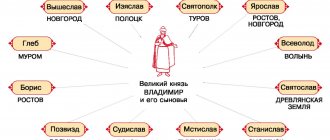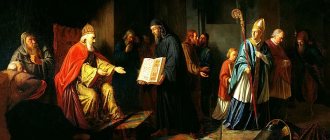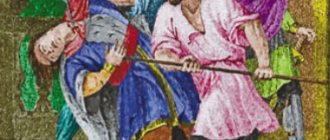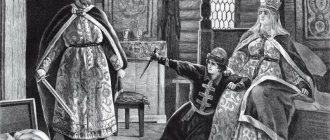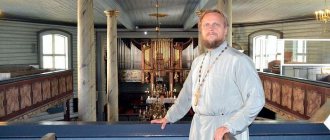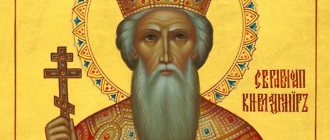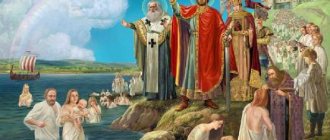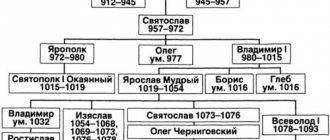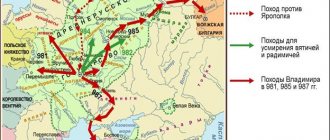Origin and upbringing
The son of the Grand Duke of Kyiv Svyatoslav Igorevich from the housekeeper Malusha, originally from the city of Lyubech, almoner (distributor of alms) Princess Olga. The son of a slave (“robichich” according to Rogneda), according to the customs of the pagans, could succeed his father-prince.
Vladimir's year of birth is unknown. His father Svyatoslav was born in 942 (the chronicle chronology is arbitrary in this period), and Vladimir’s eldest son Vysheslav was born around 977, from which historians deduce the year of Vladimir’s birth - 960, with an accuracy of several years. According to later sources of the 16th century (Nikonovskaya and Ustyug Chronicles), Vladimir Svyatoslavich was born in the village of Budutin (Budyatyn), where the angry Princess Olga exiled Malusha. As D.I. Prozorovsky suggested, Malusha violated the commandment “do not commit adultery” with Svyatoslav, and this is what aroused Olga’s anger:
“Volodimir was from Malka, Olzhina’s housekeeper; Malka is Dobrynya’s sister, and Dobrynya is Volodymyr’s uncle; and Volodymer was born in Budutino, because Olga sent her away in anger, the village was there before her, and dying she gave it to the holy Mother of God” (Nikon Chronicle).
Researchers have different opinions about the location of Budyatynoye Village. The most generally accepted version is that Vladimir Svyatoslavich was born near Pskov (village of Budnik), on the estate of his grandmother, Princess Olga. The nearby settlement of Vladimirets, named so in 1462, is also associated with his name: “in the summer of 6970, the Pskovians founded another town on Volodchina Mountain and named it Volodimirets.”
The chronicles do not report the further fate of Malusha, and the young Vladimir was sent to Kyiv, where he was under the supervision of Princess Olga. His maternal uncle, Voivode Dobrynya, may have been involved in his upbringing, since in the customs of Rus' it was customary to entrust the upbringing of heirs to senior warriors.
Prince of Novgorod
When Svyatoslav Igorevich went to war with Byzantium (this was in 970), he left Novgorod to Vladimir. Of course, the young prince could not yet make important decisions on his own, so the same Dobrynya became his wise mentor and good adviser.
Formation of a great personality
Born to a concubine, Vladimir became the third son of the Kiev Prince Svyatoslav . At that time - around 960 - Russia was a pagan state , and it could only be called a state conditionally: cities and regions were disunited and, often, refused to obey the supreme authority in Kiev. According to the canons of that period, all children of Svyatoslav had the same right of inheritance . Vladimir, the son of a slave, was subjected to ridicule from his brothers from childhood.
His grandmother, Princess Olga , and his uncle, Voivode Dobrynya . Olga's wisdom, her baptism in Byzantium and the adoption of the Christian faith, help to grow from the boy a holistic personality with leadership qualities . The military education of the senior warrior Dobrynya develops strategic thinking and the basics of combat skill in the young prince.
Vladimir's seizure of the Kyiv throne
After the death of Prince Svyatoslav in 972, Yaropolk ruled Kiev. In 977, an internecine war broke out between Yaropolk and his brothers. The specific Drevlyan prince Oleg, retreating in battle with Yaropolk, was crushed in a ditch by falling horses. Vladimir fled to the Varangian lands at this news. Yaropolk Svyatoslavich began to rule all Russia. Meanwhile, Vladimir “across the sea” recruited an army with Dobrynya and in 980 returned to Novgorod, driving out the mayor Yaropolk.
Vladimir captured Polotsk, which had sided with Kiev, killing the family of the city’s ruler, Prince Rogvolod, and on the advice of his uncle Dobrynya, Vladimir first raped Rogneda in front of her parents, and then killed her father and two brothers. He forcibly took Princess Rogneda, who had previously been betrothed to Yaropolk, as his wife. It was Rogneda’s refusal to match Vladimir that caused his revenge: the princess considered it unacceptable to marry the son of a concubine, who was Vladimir. Her words “I don’t want to rozuti robichich” (“I don’t want to take off a slave’s shoes”), according to the Slavic custom of taking off a spouse’s shoes, greatly humiliated Vladimir and Dobrynya, as they hinted at the status of Vladimir’s mother (Dobrynya’s sister).
Then, with a large Varangian army, he besieged Kyiv, where Yaropolk had locked himself up. According to the chronicle, Voivode Yaropolk Blud, bribed by Vladimir, forced Yaropolk to flee to the small town of Roden, intimidating the people of Kiev with a rebellion. In Rodna, Vladimir lured Yaropolk to negotiations, where two Varangians “raised him with their swords under their bosoms.” Vladimir took Yaropolk's pregnant wife, a former Greek nun, as a concubine.
When the Varangian army demanded tribute from the Kievites for their service, Vladimir promised them, but a month later he refused, and sent the Varangians to serve in Constantinople with advice to the Byzantine emperor to separate them to different places. Vladimir kept some of the Varangians for himself to govern the cities.
According to the chronicle, Vladimir reigned in Kyiv in 980. According to the earliest Life of Vladimir by the monk Jacob (“Memory and Praise to Prince Vladimir,” 2nd half of the 11th century), this happened on June 11, 978.
From a number of chronological considerations, the date 978 seems more likely, and the date 980 was obtained, apparently, from a secondary arrangement of the annual grid in the chronicle through incorrect recalculation. So the chronicler mentioned 37 years of Vladimir's reign, which also points to 978 as the year of Vladimir's rise to power. The new prince of Kiev took measures to reform the pagan cult. He erected a temple in Kyiv with idols of the six main gods of Slavic paganism (Perun, Khors, Dazhdbog, Stribog, Semargl and Mokosha, without Veles); there is also information that the prince practiced human sacrifices to the gods.
From primary sources it is known about the sacrifices of the Rus during the siege of Constantinople in 860 and during the siege of the Dorostol fortress by Byzantine troops, where Svyatoslav locked himself in 971. Since there is indirect information about the sympathies of the former prince Yaropolk for the Christian faith and his contacts with the Latin West, it is very likely the assumption of a pagan reaction under Vladimir, that is, the struggle against Christianity, which had previously been established in Kyiv.
Archaeological confirmation of this can be the discovery on the site of the Vladimirov Pantheon of the remains of a stone structure with traces of fresco painting - apparently, a church that existed under Yaropolk. During the persecution in Kyiv, one of the first Christian martyrs in Rus', the Varangians Fedor and John, died.
The Tale of Bygone Years conveys Vladimir’s lifestyle before baptism as follows: “Vladimir was overcome by lust, and he had wives..., and he had 300 concubines in Vyshgorod, 300 in Belgorod and 200 in Berestovo, in the village that is now called Berestovoe. And he was insatiable in fornication, bringing married women to him and corrupting girls.”
Some historians see in such a description (uncharacteristic of the lives of saints) an attempt to compare Vladimir with the biblical king Solomon. The text of “The Tale of Bygone Years” itself contains the following: “Beau [Vladimir] is a woman-lover, just like Soloman, he said, “Soloman has 700 wives, and 300 concubines... But [Solomon] was wise, but in the end he died; Behold, be silent, and finally you will find salvation.”
Thus, the idea of saving the “woman lover” Vladimir is being pursued by accepting Christianity, in contrast to Solomon, who remained a pagan.
Orthodox sources claim that after baptism, the prince released all former pagan wives from marital duties. He offered to choose a husband for Rogneda, but she refused and took monastic vows.
Reforms of this time
With all this, Vladimir during these years shows every concern for strengthening the state. He makes several successful campaigns to the west and east (against the Poles, Yatvingians, Volga Bulgarians, Khazars), subjugates a number of East Slavic tribes (Radimichi, Vyatichi) to the power of Kiev, annexes the so-called. Cherven cities (Volyn). The various regions of the Russian state are held together by stronger bonds than before. The pagan reform of Vladimir (the establishment of a pagan pantheon) indicates that the prince seeks to introduce something new into previous beliefs. The representation in Vladimir's pantheon of deities of different ethnic groups of the Russian land (Slavic, Finno-Ugric, Baltic tribes, remnants of the former Iranian population), their subordination to the princely god Perun and the introduction of a single state cult of Perun for the entire country - all this was supposed to personify the unity of the Old Russian state, supremacy of Kyiv and the Kiev prince.
However, this pagan reform, which changed only the external appearance of the old gods, could not satisfy Vladimir. Personal searches for faith, as they say, coincided with the demands of the time. Rus' finally lost the features of the previous military federation of individual tribes and turned into a single state, playing an increasingly important role in European and world politics. All this required changes in the sphere of ideology.
Some interesting facts from Vladimir's biography.
- Under Vladimir, many kilometers of defensive lines were built around Kyiv. They were called “Serpentine Ramparts” because, according to legend, battles of Russian heroes with a huge serpent, which became a habit of the Slavic lands, took place here. Watchtowers were also erected here. If the enemy approached Kyiv, then signal lights were lit - this was how they reported the approach of the enemy.
- Vladimir carried out a pagan reform in 980. 6 gods were left: Perun - the god of war and thunderstorms, Khors - the god of sunlight, Simargl - the god of the underworld, Stribog - the god of the wind, Dazhbog - the god of fertility and light, Makosh - the goddess of fertility and patroness of the clan .
- An interesting fact is the adoption of Christianity. Vladimir decided to marry the Byzantine princess Anna, the sister of Emperor Vasily 2. But he was against the marriage, since Vladimir was the illegitimate son of Svyatoslav and the housekeeper slave Miklushi. According to the agreement, Prince Vladimir undertook to help Vasily suppress the rebellion - after which the wedding was to take place. The emperor did not fulfill his promise. Then the prince captured the stronghold of Byzantium - the city of Chersonesos (Korsun). The Emperor agreed to the marriage, but on the condition that Vladimir accepted Christianity.
- The baptism of Rus' was very difficult. People did not want to forget their gods, whom their ancestors worshiped. Novgorod especially rebelled. He was baptized “with fire and sword”: Putyata (Kiev thousand) - with a sword, and Dobrynya (Vladimir’s uncle, governor in Novgorod) - with fire, when he and his soldiers set fire to the houses of the Novgorodians in order to distract them from resistance.
- After the adoption of Christianity, it was necessary to build churches and temples. Prince Vladimir introduced a tithe tax, that is, levying a tenth of income for the development and strengthening of the church. This is how the Tithe Church was built - the first church after the adoption of Christianity.
Baptism of Rus'
Tradition says that in 983, after a successful military campaign, Vladimir decided to make a human sacrifice to the pagan gods. It was decided to choose her by lot, which fell on the young man John. The young man's father Theodore, being a Christian, did not want to give up his son and began to condemn pagan idols and glorify the Christian faith. Then an angry crowd of pagans killed Theodore and his son. These were the first Christian martyrs in Rus'; the memory of the holy martyrs Theodore and his son John is celebrated on July 25 (12 according to the old style).
As the chronicles tell about the “choice of faiths” (“test of faiths”), embassies from different nations came to the prince in Kyiv in 986, calling on him to convert to their faith. First, the Volga Bulgarians of the Muslim faith came and praised Mohammed, then foreigners from Rome preached the Latin faith from the pope, and the Khazar Jews preached Judaism. The last to arrive, according to the chronicles, was a preacher sent from Byzantium. He began to tell Vladimir about Orthodoxy. To understand whose faith is better, Prince Vladimir sent nine envoys. The ambassadors visited the countries from which the preachers came. Returning to Kyiv, they told the prince everything they had seen and praised the Greek Orthodox faith. However, Vladimir did not immediately accept Christianity.
In 988, he captured Korsun (now the territory of the city of Sevastopol) and demanded Anna, the sister of the Byzantine emperors Vasily II and Constantine VIII, as his wife, threatening otherwise to go to Constantinople. The emperors agreed, demanding in turn that the prince be baptized so that his sister could marry a fellow believer. Having received Vladimir's consent, the brothers sent Anna to Korsun. There, in Korsun, Vladimir and his warriors were baptized by the bishop of Korsun, after which they performed the wedding ceremony. At baptism, Vladimir took the name Vasily, in honor of the ruling Byzantine emperor Vasily II.
Returning to Kyiv, accompanied by Korsun and Greek priests, Vladimir baptized his sons from his previous wives in a spring known in Kyiv as Khreshchatyk. Following them, many boyars were baptized.
Mass baptism of Kiev residents took place at the confluence of the Pochayna River into the Dnieper. The chronicles read: “The very next day, Vladimir went out with the Tsaritsyn and Korsuin priests to the Dnieper, and countless people gathered there. They entered the water and stood there, some up to their necks, others up to their chests, small children near the shore up to their chests, some holding babies, and adults wandering around, while the priests performed prayers, standing still...” This most important event took place, according to the chronicle chronology, in 988.
Following Kiev, Christianity gradually came to other cities of Kievan Rus: Chernigov, Volyn, Polotsk, Turov, where dioceses were created. The baptism of Rus' as a whole dragged on for several centuries - in 1024 Yaroslav the Wise suppressed the uprising of the Magi in the Vladimir-Suzdal land (a similar uprising was repeated in 1071; at the same time in Novgorod the Magi confronted Prince Gleb), Rostov was baptized only at the end of the 11th century, and in Murom, pagan resistance to the new faith continued until the 12th century.
The fight against paganism and pagans
The sharp transition from paganism to the Christian faith met with serious resistance from ordinary peasants, warriors, and artisans. Vladimir showed by his example how to deal with pagan gods (he destroyed wooden idols in Kyiv). He baptized all the boyars close to him, built Orthodox churches, but it was not immediately possible to force every inhabitant of Ancient Rus' to renounce pagan beliefs. Ordinary people did not understand why Vladimir abandoned paganism. The reform of paganism carried out by Vladimir was alien to them.
During the reign of Vladimir Svyatoslavovich and after it, throughout the country people raised uprisings, which were brutally suppressed by the squad. Until the beginning of the 13th century, more than one attempt was made to return to the previous religion, but they all ended in failure, unable to resist the authoritarian power of the Christian church. The fight against the pagans was brutal. However, historians believe that paganism did not become obsolete until the 15th century. In the villages they still believed in brownies, goblins, and mermaids. Abandoning paganism was impossible for them. And to this day, some holidays have been preserved that were previously considered exclusively pagan - Maslenitsa, Ivana bathed.
The reign of Vladimir is considered the most successful and successful after Rurik. The significance of the reign of Vladimir Svyatoslavovich for the development of the Russian state is great. He managed to complete the unification of Russian lands along political, territorial and even spiritual lines. During the reign of Vladimir Svyatoslavovich, only a few decided to challenge the power of the prince. A strong princely squad stood guard over the borders; new fortresses were built for protection, and cities were built to establish trade and other connections. Under the reign of Vladimir the Red Sun, the inhabitants of Rus' no longer fulfilled their spiritual needs in prayer in dark caves near crooked-armed idols, but in bright and spacious churches. The beginning of the reign of Vladimir Svyatoslavovich was bloody (the murder of his brothers and their comrades-in-arms), but he ends his reign not in a pagan, but in a Christian country, with harsh but fair laws. The baptism of Rus' led to the strengthening of statehood and increased its status in the eyes of its neighbors.
Baptism of Rus'
Military campaigns
- In 991, a campaign in the Dniester lands against the White Croats.
- In 992 there was a successful war with Poland for Cherven Rus.
- In 994 - 997, Vladimir repeated the campaign against the Volga-Kama Bulgars and moved to the North Caucasus.
Vladimir pursued an active foreign policy: during his reign, he concluded many agreements with the rulers of different countries. These were: Stephen I (King of Hungary), Boleslav I the Brave (King of Poland), Boleslav II (King of the Czech Republic), Sylvester II (Pope), Basil II (Emperor of Byzantium).
The problem of Rus' remained the constant raids of the Pechenegs: in 990, 992 on Pereyaslavl, 993, in 996 the battle of Vasilevo took place, in 997 an attack on Kyiv, in 1001, in 1013 the Polish-Pecheneg invasion of Rus' took place. Memories of the Pecheneg War a century later took on epic forms (the legend of the Belgorod jelly, of Nikita Kozhemyak, etc.). For defense against the Pechenegs, a number of fortresses were built along the southern border of Kievan Rus. Along the southern and southeastern borders of what was then Rus', on the right and left sides of the Dnieper, rows of earthen trenches and outposts were built to deter attacks by nomads. According to the testimony of the Byzantine Emperor Constantine VII Porphyrogenitus, the Pechenegs roamed at a distance of one day's travel from Rus'.
In 1006 – 1007 The German missionary Bruno of Querfurt passed through Kyiv, heading to the Pechenegs to preach the Gospel. He stopped to stay with Prince Vladimir, whom he calls Lord of the Russians in a letter to Emperor Henry II. Prince Vladimir persuaded the missionary not to go to the Pechenegs, saying that with them he would not find souls to save, but rather would die a shameful death. The prince could not persuade Bruno and volunteered to accompany him and his retinue to the borders of his land, “which he fenced on all sides with a strong palisade over a very long distance due to the enemies wandering around them.” Bruno was probably talking about the Serpentine Shafts, the length of which in the Kyiv region is about 800 kilometers.
Results and results
Let us briefly list the main achievements of Vladimir I Svyatoslavich in domestic politics:
- As a result of the civil strife of 977-980, Vladimir killed his brother Yaropolk and came to power
- At the beginning, the board was faced with the need to suppress the uprisings of the Vyatichi and Radimichi
- At first he tried to focus on paganism, then he converted to Christianity and baptized Rus', which caused religious conflicts.
- Faced with constant raids by the Pechenegs, he began to build cities on the borders with the steppe and resettle the northern tribes there.
- The beginning of coinage in Rus' dates back to the reign of Vladimir.
- He hoped to transfer the title of Grand Duke to his son Boris, bypassing the existing tradition of succession by seniority, which was one of the reasons for the second internecine war in Rus'
Section "Vladimir I"
Domestic policy of Vladimir the Great
Vladimir's internal policy was conducted with the participation of a council of military commanders and elders of different cities.
During his life, Vladimir carried out 4 main reforms:
- Administrative reform. Vladimir abolished the “tribal” reigns, headed by the tribal nobility and the princely dynasty. Such reigns were subject to Kyiv only formally. Prince Vladimir divided the territory of the Old Russian state into 8 administrative lands, which were called volosts: Novgorod, Polotsk, Rostov, Murom, Turov, Derevskaya, Vladimir and Tmutarakan. The “grand-ducal domain” became a separate (“federal”) district, which included Kyiv, Chernigov and Pereyaslav.
- Military reform. Elimination of “tribal” military formations and unification of the military system. In addition, Vladimir distributed border lands in exchange for military service. The latter, together with the construction of several impregnable fortresses on the borders, significantly reduced the vulnerability of the Russian state.
- Judicial reform. The creation and subsequent division of courts into secular (city) and ecclesiastical (episcopal). The only legal document of that time that has reached us is the Church Charter. The death penalty was replaced by viru (ransom in gold or silver).
- Religious reform. The baptism of Rus', the establishment of Christianity as the official state religion.
a brief description of
The domestic policy of Vladimir I Svyatoslavich at the beginning of his reign was focused on a single goal - the seizure and retention of power. Having killed his brother Yaropolk during the civil strife and captured Kyiv, Vladimir tried to carry out the so-called. "pagan" reform, but it was not successful. After the suppression of the uprisings of the Radimichi and Vyatichi, Vladimir began to think about a radical change of religion in the state. Between Islam, Judaism, Latin and Greek Christian churches, the choice fell on the latter, because... Vladimir's baptism and his spread of Christianity in Rus' was a condition for marriage with the Byzantine princess Anna.
General scheme of the domestic policy of Vladimir I Svyatoslavich
Faced with the need to confront the Pechenegs, Vladimir launched the construction of fortified cities and resettled representatives of the northern tribes there.
At the end of his reign, the prince intended to change the principle of inheritance and, instead of his eldest son, entrust the management of Kiev to one of his favorite younger sons, Boris. After the death of Vladimir, his heirs unleashed another bloody civil strife.
Foreign policy of Prince Vladimir
Prince Vladimir was a strong and warlike ruler who pursued an active foreign policy. In relations with neighboring states, he used both military force and diplomatic contacts.
In particular, the prince recaptured the Cherven cities in Poland. He also conquered the lands of the Yatvingians, a wild but courageous Lithuanian tribe who lived in the forests between Poland and Lithuania. According to the Icelandic chronicler, all the tribes living from the Neman to the Gulf of Finland paid tribute to Vladimir.
During the reign of Vladimir, Kyiv maintained ties with the West, begun by Olga. Ambassadors of the Pope visited the Kyiv prince twice (in 988 and 991). In 994 and 1000 Vladimir's embassies went to Rome. There were repeated exchanges of embassies with Germany.
In an effort to protect the southern borders of Kievan Rus, in addition to military campaigns against the Pechenegs, the prince made peace with the Bulgarians. They solemnly promised to live in harmony with Kiev and confirmed their words with an oath: “Shall we then break our agreement, like a stone floats, and hops drown in water.” In his relations with Byzantium, Prince Vladimir sought to establish good neighborly relations, which were based on a common faith. At the same time, he successfully prevented the Byzantines' attempts to make Kievan Rus a state dependent on themselves. Having established connections with the Pope, he forced Byzantium, which did not want to expand his sphere of influence in Rus', to treat the Russians as equals.
Vladimir well understood the importance of the traditional practice of that time, the so-called “marriage diplomacy”, and actively used it to maintain stable relations with other countries. Each such marriage with representatives of the ruling dynasties of European countries was a kind of seal that secured a political union. The eldest son Svyatopolk was married to the daughter of the Polish king Boleslav the Brave, Yaroslav became the son-in-law of the Swedish king Olaf. One daughter, Premislava, was married to the Hungarian king Vladislav the Lysy, and the second to the Czech king Boleslav the Red.
Chronology of Vladimir's life and work
| 980 | Pagan reform |
| 981-982 | Subdued the Vyatichi |
| 984 | Subdued the Radimiches and Croats |
| 985 | Campaign against Danube Bulgaria, peace treaty with it. |
| 988 | Acceptance of Christianity |
| 989-996 | The Church of the Tithes (the first) - the Assumption of the Virgin Mary - was built in Kyiv. |
| 989 | Church of St. Sophia in Novgorod. |
| 992, 995 | Battles with the Pechenegs |
| 1010 | Foundation of the city of Vladimir. |
Vladimir the Saint with a cross in his hands is depicted on the “Millennium of Russia” monument in Novgorod, opened in 1862. The author is the sculptor Mikeshin M.O. The people expressed their respect for this ruler of Kievan Rus.
Memory of Saint Vladimir in Rus'
- Many epics have been written about the period of Vladimir's reign. It was during his reign that the epic heroes Ilya Muromets, Alyosha Popovich and Dobrynya Nikitich became famous.
- In 1782 Catherine the Second established the Imperial Order of St. Vladimir of 4 degrees.
- There are many monuments to Vladimir: in Kyiv, Belgorod, Vladimir, Korosten and even in London.
- A bay in the Sea of Japan is named after Vladimir.
- Karpov A.Yu. wrote the novel “Vladimir the Saint” in 1997.
- Films about Vladimir were made: in 1993, “Vladimir the Holy,” directed by Yu. Timoshevsky, in 2006. cartoon "Prince Vladimir".
You can find other portraits of historical figures on the site.
Author: Melnikova Vera Aleksandrovna
Last years
In the last years of his life, Vladimir was probably going to change the principle of succession to the throne and bequeath power to his beloved son Boris. In any case, it was Boris who he entrusted with his squad. The two eldest of the surviving sons - Svyatopolk of Turov and - almost simultaneously rebelled against their father in 1014. Therefore, when Vladimir died of illness in the country residence of Berestov on July 15, 1015, those around him hid his death. The fact is that Svyatopolk was in Kyiv: he should not have found out about this before the townspeople, otherwise he would have tried to usurp power. The prince's body, wrapped in a carpet, was secretly taken out at night on a sleigh and brought to the Kyiv Tithe Church, where he was buried; The marble sarcophagi of Vladimir and his wife stood in the middle of the temple. The Tithe Church was destroyed by the Mongols in 1240.
In 1632 - 36 In Kyiv, during the dismantling of the ruins, old sarcophagi were discovered, taken by Metropolitan Peter Mogila for the burial of Vladimir and Anna, and then, after the remains were removed, they were buried again. The identification of the tomb (or tombs) was made based on the inscription, which, however, is clearly of late origin and contains factual contradictions (dating from the Nativity of Christ, etc.). The burial place was re-excavated by N. E. Efimov in 1826; sarcophagi were indeed found, but they did not correspond to the description of the 17th century. The remains (relics) removed from the burial were distributed to Kyiv and Moscow cathedrals and have now been lost. Modern researchers doubt that it was really Vladimir and Anna.
Strengthening the statehood of Kievan Rus: first reforms
Vladimir, later nicknamed the Red Sun by the people, did a lot to strengthen the statehood of Kievan Rus and complete the process of unification of all East Slavic tribes. A year after approval in Kyiv, he annexed the cities of Peremysh and Cherven (Poland) to Kievan Rus, and again imposed tribute on the Vyatichi.
Having barely established himself in Kyiv, Vladimir carries out two reforms at once - spiritual and territorial. The first religious reform in Russia (the second reform - the baptism of Russia) , concerned changes in the order of worship of pagan gods and the promotion of Perun to the first place among them, the goal of the second ( the first tax reform in Russia ) was the strengthening of princely power locally.
Unlike his grandmother Olga, Vladimir remained a pagan. By his order, statues (idols) of 6 Slavic pagan gods were erected in the center of Kyiv, among which were Perun, Khors, Dazhdbog, Stribog, Semargl and Mokosh. The prince proclaimed Perun to be the main god. These actions were a huge success among the prince’s fellow tribesmen, who, like him, still remained pagans. According to Vladimir's idea, Kyiv was assigned the role of the spiritual center of all pagan Rus'.
Fearing new unrest between the princes, Vladimir sends his governors to the cities. The concept of a “tribal great and bright prince,” who ruled independently of the will of the prince of Kyiv and was only formally subordinate to him, disappears. Vladimir's governors did not have princely power, but had the right:
- judge;
- maintain internal order with the help of local squads;
- collect taxes.
The position of governor was honorable (it brought income and respect); only those especially close to the prince could receive it. In Novgorod, Turov, Polotsk, Rostov, Murom, Pskov and other significant political centers of Rus', Vladimir’s sons and their advisers were present as governors. The main difference between a governor and a simple prince was that, if he wanted, Vladimir could remove a person he did not like from his post and replace him with someone more flexible. The appearance of people loyal to Vladimir in places remote from Kyiv contributed to the centralization of the state. Princely power increased significantly.
As under Olga and Svyatoslav, the main form of collecting tribute was polyudye. The exception was cases when tribute was collected “from the plow”, from each family (according to the number of adult men), and not from the whole village.
Vladimir adopts new laws after agreement with a specially created council. The members of the council were senior warriors and elders representing different cities. The death penalty was not introduced in Rus'; criminals were punished with vira (monetary compensation for damage caused).
The strengthening of ancient Russian statehood is facilitated by the founding of new cities and the implementation of monetary reform in Russia . After the campaign against the Vyatichi and the annexation of two Polish cities to Rus', Vladimir ordered the foundation of the city of Vladimir-Volynsky.
The first Russian coins were minted according to the model of the Byzantine coins - gold (zlatniks) and silver (srebniks). There was no need for their own coins, but the minting of money was always perceived as a sign of the sovereignty of the state. Each such coin featured the prince himself and the inscription “Vladimir on the throne.”
Silver coins. Vladimir's personal sign on the coin
conclusions
Prince Vladimir entered the history of Kievan Rus as an energetic reformer, whose activities contributed to the strengthening of the country. Evidence of the recognition of his merits in Rus' was the exaltation of the prince by the people in epics as “Vladimir the Red Sun” and his canonization by the Orthodox Church. In the West, Vladimir was respectfully called “the ruler of the Rus, powerful thanks to his kingdom and wealth.”
The territory of Kievan Rus at the end of Vladimir’s reign reached 800 km2 and generally corresponded to the limits of settlement of the East Slavic community.
Vladimir's introduction of Christianity as the state religion of Kievan Rus had the significance of an epochal revolution and determined its further development. Thanks to the introduction of Christianity, Kievan Rus was able to join the ranks of the Christian states of the world and maintain equal relations with Byzantium, Germany and other states.
At the end of the X - beginning of the XI century. Kievan Rus achieved unprecedented power, its internal position strengthened, and its international authority grew.
Video
Acceptance of Christianity
| Reasons for accepting Christianity. | The meaning of accepting Christianity. |
| Paganism led to the isolation of Rus', as it was considered a barbaric country | The international authority of Rus' has increased. |
| Paganism hindered the strengthening of statehood | The power of the prince increased. |
| A religion with one god was needed to unite the people and strengthen the power of the prince | The church began to play a major role in the country, uniting the people and strengthening the princely power. |
| Social inequality also required the emergence of a new ideology in order to justify the rich and somehow console the poor with the hope of a happy life in paradise. | Development of culture, writing, education. Christian laws appeared - do not kill, do not steal, and many others, which contributed to the formation of moral principles. |
| However, Christianity contributed to increased exploitation by condemning protests and persecuting dissidents. |
Expanding land and strengthening borders
In those days, the princely army was constantly in a state of war : either new lands were conquered, or uprisings in those already conquered were suppressed. Beginning in 981, Vladimir subjugated Polish cities, Balto-Lithuanian tribes and Radimichi. An alliance with the Torci in the war with Volga Bulgaria does not provide an advantage and leads to a forced truce in 985 . Then the Grand Duke conquers the Khazars and imposes tribute on them.
The opposition to the Pecheneg union of tribal peoples lasted several decades. The main Pecheneg raids occurred in 990, 993 and 996, and in 1001 and 1013 their horde, in alliance with the Poles, advanced deep into the country all the way to Kyiv. Vladimir builds border fortresses, earthen ramparts, and erects well-fortified observation posts. But the prince fails to completely defeat the nomads; Only through negotiations does he achieve a truce.
Numerous military campaigns and conquests force neighboring countries, and then the whole world, to recognize the strength and spirit of the Kiev state . Unknown to this day, the Slavs were presented to the Western world as something dark, barbaric, and pagan. They were feared, but at the same time tried to conquer because of the large territories. Vladimir's rule, its foreign and domestic policies, put Kievan Rus on the same level as the Tsar-city of that era - Constantinople . European states began to seek an alliance with the Slavic power, both trade and economic, and military-political.
Brief description of the main events of Vladimir's reign
- 960 g . - birth of Vladimir Svyatoslavich.
- 970 g . - the beginning of the rule of the Novgorod lands.
- 972 _ - death of the Kyiv prince Svyatoslav; the beginning of the reign of Yaropolk.
- 977 _ - civil strife between brothers; Vladimir's flight to the Varangians.
- 980 g . – return of Vladimir to Novgorod; his marriage to Rogneda; construction of a pagan pantheon led by Perun.
- 981 _ - campaign against Przemysl and Cherven, imposition of tribute on Polish cities; conquest of the Vyatichi.
- 983 _ – subjugation of the Balto-Lithuanian tribes, Sudovia.
- 984 _ - conquest of the Radimichi.
- 985 g . - battle with the Bulgars and truce.
- 986 _ - test of faith, advice on choosing a new religion for the Kievan kingdom.
- 987 _ - an agreement with the Byzantine emperor on military support in suppressing the rebels of Bardas Phocas and marriage with Anna of Byzantium.
- 988 _ - baptism of the Grand Prince of Kyiv Vladimir Svyatoslavich and his soldiers.
- 989 _ - homecoming; baptism of Kyiv residents.
- 990 g . - baptism of Novgorodians; attack of the Pecheneg tribes on Rus'.
- 992 - campaign in the Carpathian region against the White Croats, with the further annexation of the latter to Ancient Russia.
- 993 _ – new raids of nomads.
- 996 _ – drawing up church regulations; Pecheneg attack.
- 997 _ - Pecheneg raids on Kyiv.
- 1000 g . - military campaign against Armenia; trip to the Danube; death of Rogneda.
- 1006 _ – trade relations with Volga Bulgaria.
- 1011 _ - death of the Christian wife Anna.
- 1013 _ - new invasions of Pecheneg troops on Russian soil.
- 1015, July 15 - death of Vladimir.
